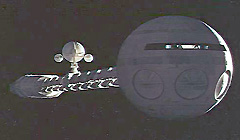"At the present rate of progress, it is almost impossible to imagine any technical feat that cannot be achieved - if it can be achieved at all - within the next few hundred years."
- Sir Arthur C. Clarke, 1983
(Source: http://www.quotationspage.com/quotes/Arthur_C._Clarke/)
The Clarke Explorer is a general-purpose civilian craft designed as a cheap, early-game ship for StarMade. It's design is inspired by the Discovery One from 2001: A Space Odyssey, with design suggestions from the website http://www.projectrho.com/public_html/rocket/.

Illustration 1: The Clarke Explorer from port-side rear, slight elevation
Because it is a civilian vessel with a roleplay-heavy design, the weapon systems are particularly weak.
The overall features from back to front:
Large nozzle (just a single nozzle: directional thrust should provide an explanation for mid-flight turns and such. PD turrets on four sides.)
Rear radiation shield (attached to the main reactor block)
Main Reactor Block (radiation symbol in door blocks on top, bottom, and sides)
Forward radiation shield (attached to the main reactor block)
Main Shaft (attached: 8 blue pressure tanks and 12 PD turrets, as well as the four black radiating heat fins, surrounded by white protective fins. The core shaft is filled with system utility blocks, but is supposed to roleplay-represent a large fuel tank for the reactor and engine nozzle. Contains the ship core near the habitation module, at the base of the access halls, for maximum protection from all angles.)
Habitation Module (attached: 8 rapid-fire weapon turrets. Contains the internal hanger, a number of multipurpose rooms, the majority of the walkways, the ship's tiny forward guns (mostly for vaporizing scrap), small salvage arrays, a small set of tiny missile launchers, a cargo bay, and a dock to allow nose-to-nose docking.)

Illustration 2: View of the front of the Habitation Module, the nose of the ship.

Illustration 3: Nose Cargo Bay Internal View in the Habitation Module
Dual-redundant jump drives
Scanner
Jammer (limited-time use due to insufficient power generation)
Mass: 33.4 K
Thrust/Mass ratio exceeds 1:1
1.25 M e/s
nearly 43 M power storage
7.5 M shields

Illustration 4: Raw Statistics for the actual ship, from build mode
I wanted to keep the ship shorter than 200 blocks, so it has a very squat appearance, compared to the Discovery One.

Illustration 5: Discovery One from the movie 2001: A Space Odyssey
Altering Your Ship:
The blue pressure tanks mounted along the shaft, alongside each set of fins, are unshielded, pure-roleplay, aesthetic features. They are mounted on turret docks, and can be easily replaced by actual fighting turrets. Plus, there's room for 4 more 7x7x7 turrets behind the rear radiation shield plate.
Ship docks:
Four small shuttle-pod docks along the shaft, forward of the smaller pressure tanks, each one overlapping a 3x3 access door relatively close to the core.
Four small shuttle docks inside the criss-cross runway/shuttle bay in the center of the Habitation Module. (13x15x19)
One large ship dock in the center of the nose face. The bounding box is larger than the Clarke Explorer itself.
(Dedicated to the memory of Sir Arthur C. Clarke: http://www.latimes.com/local/obituaries/la-me-clarke19mar19-story.html)
- Sir Arthur C. Clarke, 1983
(Source: http://www.quotationspage.com/quotes/Arthur_C._Clarke/)
The Clarke Explorer is a general-purpose civilian craft designed as a cheap, early-game ship for StarMade. It's design is inspired by the Discovery One from 2001: A Space Odyssey, with design suggestions from the website http://www.projectrho.com/public_html/rocket/.
Illustration 1: The Clarke Explorer from port-side rear, slight elevation
Because it is a civilian vessel with a roleplay-heavy design, the weapon systems are particularly weak.
The overall features from back to front:
Large nozzle (just a single nozzle: directional thrust should provide an explanation for mid-flight turns and such. PD turrets on four sides.)
Rear radiation shield (attached to the main reactor block)
Main Reactor Block (radiation symbol in door blocks on top, bottom, and sides)
Forward radiation shield (attached to the main reactor block)
Main Shaft (attached: 8 blue pressure tanks and 12 PD turrets, as well as the four black radiating heat fins, surrounded by white protective fins. The core shaft is filled with system utility blocks, but is supposed to roleplay-represent a large fuel tank for the reactor and engine nozzle. Contains the ship core near the habitation module, at the base of the access halls, for maximum protection from all angles.)
Habitation Module (attached: 8 rapid-fire weapon turrets. Contains the internal hanger, a number of multipurpose rooms, the majority of the walkways, the ship's tiny forward guns (mostly for vaporizing scrap), small salvage arrays, a small set of tiny missile launchers, a cargo bay, and a dock to allow nose-to-nose docking.)
Illustration 2: View of the front of the Habitation Module, the nose of the ship.
Illustration 3: Nose Cargo Bay Internal View in the Habitation Module
Dual-redundant jump drives
Scanner
Jammer (limited-time use due to insufficient power generation)
Mass: 33.4 K
Thrust/Mass ratio exceeds 1:1
1.25 M e/s
nearly 43 M power storage
7.5 M shields
Illustration 4: Raw Statistics for the actual ship, from build mode
I wanted to keep the ship shorter than 200 blocks, so it has a very squat appearance, compared to the Discovery One.

Illustration 5: Discovery One from the movie 2001: A Space Odyssey
Altering Your Ship:
The blue pressure tanks mounted along the shaft, alongside each set of fins, are unshielded, pure-roleplay, aesthetic features. They are mounted on turret docks, and can be easily replaced by actual fighting turrets. Plus, there's room for 4 more 7x7x7 turrets behind the rear radiation shield plate.
Ship docks:
Four small shuttle-pod docks along the shaft, forward of the smaller pressure tanks, each one overlapping a 3x3 access door relatively close to the core.
Four small shuttle docks inside the criss-cross runway/shuttle bay in the center of the Habitation Module. (13x15x19)
One large ship dock in the center of the nose face. The bounding box is larger than the Clarke Explorer itself.
(Dedicated to the memory of Sir Arthur C. Clarke: http://www.latimes.com/local/obituaries/la-me-clarke19mar19-story.html)




